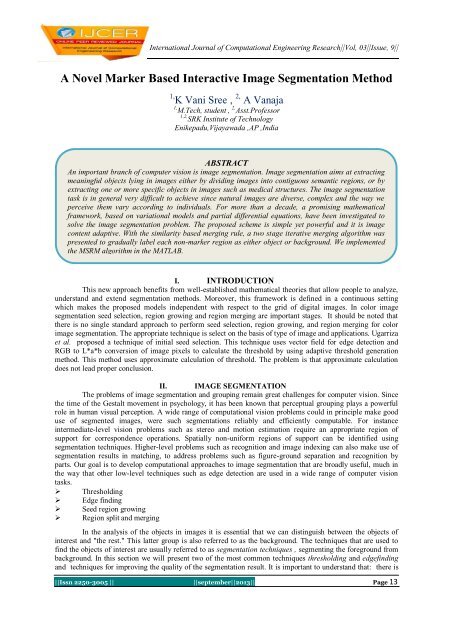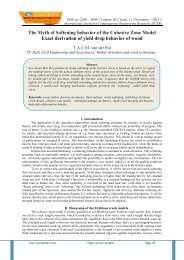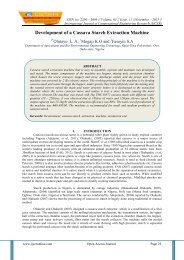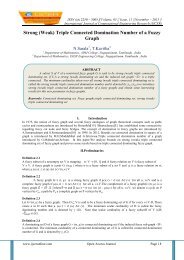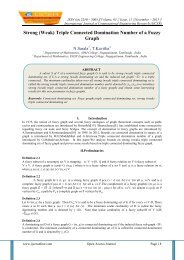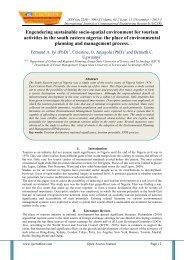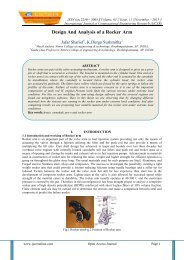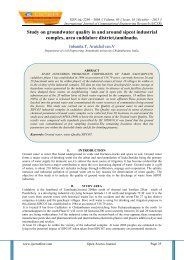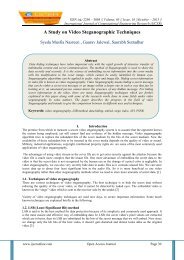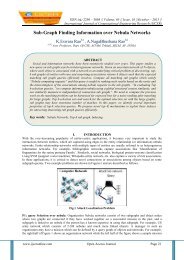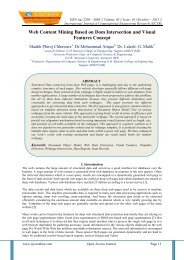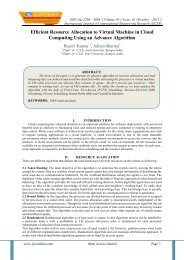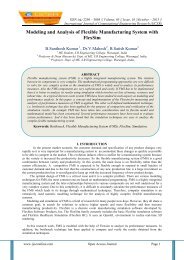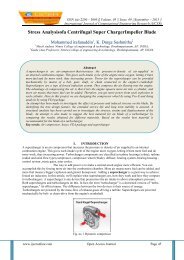International Journal of Computational Engineering Research(IJCER)
International Journal of Computational Engineering Research(IJCER) is an intentional online Journal in English monthly publishing journal. This Journal publish original research work that contributes significantly to further the scientific knowledge in engineering and Technology.
International Journal of Computational Engineering Research(IJCER) is an intentional online Journal in English monthly publishing journal. This Journal publish original research work that contributes significantly to further the scientific knowledge in engineering and Technology.
You also want an ePaper? Increase the reach of your titles
YUMPU automatically turns print PDFs into web optimized ePapers that Google loves.
<strong>International</strong> <strong>Journal</strong> <strong>of</strong> <strong>Computational</strong> <strong>Engineering</strong> <strong>Research</strong>||Vol, 03||Issue, 9||<br />
A Novel Marker Based Interactive Image Segmentation Method<br />
1, K Vani Sree , 2, A Vanaja<br />
1, M.Tech, student , 2, Asst.Pr<strong>of</strong>essor<br />
1,2, SRK Institute <strong>of</strong> Technology<br />
Enikepadu,Vijayawada ,AP ,India<br />
ABSTRACT<br />
An important branch <strong>of</strong> computer vision is image segmentation. Image segmentation aims at extracting<br />
meaningful objects lying in images either by dividing images into contiguous semantic regions, or by<br />
extracting one or more specific objects in images such as medical structures. The image segmentation<br />
task is in general very difficult to achieve since natural images are diverse, complex and the way we<br />
perceive them vary according to individuals. For more than a decade, a promising mathematical<br />
framework, based on variational models and partial differential equations, have been investigated to<br />
solve the image segmentation problem. The proposed scheme is simple yet powerful and it is image<br />
content adaptive. With the similarity based merging rule, a two stage iterative merging algorithm was<br />
presented to gradually label each non-marker region as either object or background. We implemented<br />
the MSRM algorithm in the MATLAB.<br />
I. INTRODUCTION<br />
This new approach benefits from well-established mathematical theories that allow people to analyze,<br />
understand and extend segmentation methods. Moreover, this framework is defined in a continuous setting<br />
which makes the proposed models independent with respect to the grid <strong>of</strong> digital images. In color image<br />
segmentation seed selection, region growing and region merging are important stages. It should be noted that<br />
there is no single standard approach to perform seed selection, region growing, and region merging for color<br />
image segmentation. The appropriate technique is select on the basis <strong>of</strong> type <strong>of</strong> image and applications. Ugarriza<br />
et al. proposed a technique <strong>of</strong> initial seed selection. This technique uses vector field for edge detection and<br />
RGB to L*a*b conversion <strong>of</strong> image pixels to calculate the threshold by using adaptive threshold generation<br />
method. This method uses approximate calculation <strong>of</strong> threshold. The problem is that approximate calculation<br />
does not lead proper conclusion.<br />
II. IMAGE SEGMENTATION<br />
The problems <strong>of</strong> image segmentation and grouping remain great challenges for computer vision. Since<br />
the time <strong>of</strong> the Gestalt movement in psychology, it has been known that perceptual grouping plays a powerful<br />
role in human visual perception. A wide range <strong>of</strong> computational vision problems could in principle make good<br />
use <strong>of</strong> segmented images, were such segmentations reliably and efficiently computable. For instance<br />
intermediate-level vision problems such as stereo and motion estimation require an appropriate region <strong>of</strong><br />
support for correspondence operations. Spatially non-uniform regions <strong>of</strong> support can be identified using<br />
segmentation techniques. Higher-level problems such as recognition and image indexing can also make use <strong>of</strong><br />
segmentation results in matching, to address problems such as figure-ground separation and recognition by<br />
parts. Our goal is to develop computational approaches to image segmentation that are broadly useful, much in<br />
the way that other low-level techniques such as edge detection are used in a wide range <strong>of</strong> computer vision<br />
tasks.<br />
Thresholding<br />
Edge finding<br />
Seed region growing<br />
Region split and merging<br />
In the analysis <strong>of</strong> the objects in images it is essential that we can distinguish between the objects <strong>of</strong><br />
interest and "the rest." This latter group is also referred to as the background. The techniques that are used to<br />
find the objects <strong>of</strong> interest are usually referred to as segmentation techniques , segmenting the foreground from<br />
background. In this section we will present two <strong>of</strong> the most common techniques thresholding and edgefinding<br />
and techniques for improving the quality <strong>of</strong> the segmentation result. It is important to understand that: there is<br />
||Issn 2250-3005 || ||september||2013|| Page 13
A Novel Marker Based Interactive Image…<br />
no universally applicable segmentation technique that will work for all images, and no segmentation technique<br />
is perfect.<br />
III. GEOMETRIC FLOW METHOD<br />
The block diagram <strong>of</strong> geometric flow method as shown below<br />
Image<br />
Image<br />
Initial<br />
control<br />
points<br />
Fixed<br />
partitions<br />
Image<br />
resampling<br />
B-spline method<br />
L2-gradient<br />
flow<br />
Geometric flows, as a class <strong>of</strong> important geometric partial differential equations, have been highlighted<br />
in many areas, with Computer Aided Geometric Design is probably the field that benefited most from geometric<br />
flow methods. The frequently used geometric flows include mean curvature flow (MCF), weighted MCF,<br />
surface diffusion flow and Willmore flow etc. Different flows exhibit different geometric properties that could<br />
meet the requirement <strong>of</strong> various applications. The biharmonic equation, which is linear, has been used for<br />
interactive surface design. MCF and its variants, which are second order equations and also the most important<br />
and effective flows, have been intensively used for fairing and denoising surface meshes. MCF cannot achieve<br />
the G1 continuity at the boundary, thus for applications demanding high level <strong>of</strong> smoothness, higher order<br />
equations have to be used, e.g. the surface diffusion flow for surface fairing, and the Willmore flow for surface<br />
restoration, The construction <strong>of</strong> geometric flows is not a trivial task. In early days many geometric flows were<br />
manually manufactured by combining several geometric entities and differential operators, thus were lack <strong>of</strong><br />
physical or geometric meaning. This drawback can be overcome by the construction <strong>of</strong> gradient descent flow.<br />
Gradient descent flow method can transform an optimization problem into an initial value (initial-boundary<br />
value) problem <strong>of</strong> an ordinary differential equation and thus is widely used in variational calculus. Constructing<br />
gradient descent flow needs to address two main issues, the definition <strong>of</strong> gradient and suitable choice <strong>of</strong> inner<br />
products. For a generic nonlinear energy functional, the gradient can be defined by Gˆ ateaux derivative. For the<br />
same energy functional, different inner products will generate different geometric flows, some <strong>of</strong> which have<br />
been mentioned above.<br />
IV. MARKER BASED SEGMENTATION<br />
Efficient and effective image segmentation is an important task in computer vision and object<br />
recognition. Since fully automatic image segmentation is usually very hard for natural images, interactive<br />
schemes with a few simple user inputs are good solutions. This paper presents a new region merging based<br />
interactive image segmentation method. The users only need to roughly indicate the location and region <strong>of</strong> the<br />
object and background by using strokes, which are called markers. A novel maximal-similarity based region<br />
merging mechanism is proposed to guide the merging process with the help <strong>of</strong> markers. A region R is merged<br />
with its adjacent region Q if Q has the highest similarity with Q among all Q's adjacent regions. The proposed<br />
method automatically merges the regions that are initially segmented by mean shift segmentation, and then<br />
effectively extracts the object contour by labeling all the non-marker regions as either background or object. The<br />
region merging process is adaptive to the image content and it does not need to set the similarity threshold in<br />
advance.<br />
Extensive experiments are performed and the results show that the proposed scheme can reliably<br />
extract the object contour from the complex background. In marker based segmentation, an initial segmentation<br />
is required to partition the image into homogeneous regions for merging. Any existing low level segmentation<br />
methods, such as super-pixel [13], meanshift [14,15], watershed [16] and level set [17], can be used for this step.<br />
In this paper, we choose to use the mean shift method for initial segmentation because it has less over<br />
segmentation and can well preserve the object boundaries. Particularly, we use the mean shift segmentation<br />
s<strong>of</strong>tware—the EDISON System [18]—to obtain the initial segmentation map.<br />
||Issn 2250-3005 || ||september||2013|| Page 14
A Novel Marker Based Interactive Image…<br />
For detailed information about mean shift and the EDISON system, please refer to [19]. In this<br />
method, we only focus on the region merging. Several general-purpose algorithms and techniques have been<br />
developed for image segmentation. Since there is no general solution to the image segmentation problem, these<br />
techniques <strong>of</strong>ten have to be combined with domain knowledge in order to effectively solve an image<br />
segmentation problem for a problem domain.<br />
V. EXPERIMENTAL RESULTS<br />
The execution time <strong>of</strong> the MSRM depends on a couple <strong>of</strong> factors, including the size <strong>of</strong> the image, the<br />
initial segmentation result, the user input markers and the content <strong>of</strong> the image. We implement the MSRM<br />
algorithm in the MATLAB 7.0 programming environment and run it on a PC with P4 2.6GHz CPU and<br />
1024MB RAM.<br />
Click the set object marker radio button<br />
Mark the straight lines on dog objects<br />
||Issn 2250-3005 || ||september||2013|| Page 15
A Novel Marker Based Interactive Image…<br />
Click the set background marker radio button and then straight line(blue line) edges <strong>of</strong> dog objects and then<br />
click interactive region merging<br />
Multiple object extraction: (a) initial mean shift segmentation and interactive information. The two green<br />
markers mark two objects. (b) The two extracted objects using the marker based segmentation method.<br />
||Issn 2250-3005 || ||september||2013|| Page 16
A Novel Marker Based Interactive Image…<br />
a) original image b) final segmentation result using geometric flow approach method<br />
VI. CONCLUSION<br />
This paper proposed a novel marker based interactive image segmentation method. The image is<br />
initially segmented by mean shift segmentation and the users only need to roughly indicate the main features <strong>of</strong><br />
the object and background by using some strokes, which are called markers. Since the object regions will have<br />
high similarity to the marked object regions and so do the background regions, a novel maximal similarity based<br />
region merging mechanism was proposed to extract the object. The proposed scheme is simple yet powerful and<br />
it is image content adaptive. With the similarity based merging rule, a two stage iterative merging algorithm was<br />
presented to gradually label each non-marker region as either object or background.<br />
REFERENCES<br />
[1[ Chaobing Huang, Quan Liu, ―Color image retrieval using edge and edge-spatial features‖, Chinese Optics Letters 2006, vol.4,no.<br />
8,pp.457-459.<br />
[2]. Luis Ugarriza, Eli saber, ―Automatic Image Segmentation by Dynamic Region Growth and Multiresolution Merging‖ IEEE<br />
Transactions On Image Processing ,vol .18no 10):2001<br />
[3]. J. Fan, David, K. Y. Yau, A. K. Elmagarmid. ―Automatic Image Segmentation by Integrating Color-Edge Extraction and Seeded<br />
Region Growing‖. IEEE Transactions On Image Processing, vol.10,no.10:oct2001<br />
[4]. H.D. Cheng, X.H. Jiang, J. Wang, Color image segmentation based on homogram thresholding and region merging, Pattern<br />
Recognition 35<br />
(2002) 373–393.<br />
[5]. P.K. Saha, J.K. Udupa, Optimum image threshold via class uncertainty and region homogeneity, IEEE Transactions on Pattern<br />
Analysis and Machine Intelligence , vol.23, no.7 (2001) 689–706.<br />
[6]. R. Haralick and L.Shapiro Computer and Robot Vision. New York:Addison-Wesley, 1992, vol. 1, pp. 28–48.<br />
[7]. T. Cover and J.Thomas, Elements <strong>of</strong> Information Theory. New York: Wiley, 1991.<br />
[8]. C. Chou and T. Wu, ―Embedding color watermarks in color images,‖ EURASIP J. Appl. Signal Process., vol. 2003, no. 1, pp. 32–<br />
40, Oct.2003.<br />
[9]. Y. J. Zhang, ―A survey on evaluation methods for image segmentation,‖ Pattern Recognit. Soc., vol. 29, no. 8, pp. 1335–1346,<br />
1996.<br />
[10]. R. Adams, L.Bisch<strong>of</strong>, Seeded region growing, IEEE Transactions on Pattern Analysis and Machine Intelligence 16 (6) (1994) 641–<br />
647.<br />
[11]. Schmid, P.: Image segmentation by color clustering, http://www.schmid-saugeon.ch/publications.html, 2001<br />
[12]. Digital Image Processing , R.C. Gonzalez, R.E. Woods, S.L. Eddins.<br />
[13] Q. Yang, C. Wang, X. Tang, M. Chen, Z. Ye, Progressive cut: an image cutout algorithm that models user intentions, IEEE<br />
Multimedia 14 (3) (2007) 56–66.<br />
[14] M. Sonka, V. Hlavac, R. Boyle, Image Processing, Analysis and Computer Vision, Thomson, 2007.<br />
[15] B. Sumengen, Variational image segmentation and curve evolution on natural images, Ph.D. Thesis, University <strong>of</strong> California.<br />
[16] EDISON s<strong>of</strong>tware. http://www.caip.rutgers.edu/riul/research/code.html.<br />
[17] Y. Li, J. Sun, C. Tang, H. Shum, Lazy snapping, SIGGRAPH 23 (2004) 303–308.<br />
[18] Y. Li, J. Sun, H. Shum, Video object cut and paste, SIGGRAPH 24 (2005) 595–600.<br />
[19] S. Paris, F. Durand, A topological approach to hierarchical segmentation using mean shift, in: Proceedings <strong>of</strong> the IEEE Conference<br />
on Computer Vision and Pattern Recognition, 2007, pp. 1–8.<br />
||Issn 2250-3005 || ||september||2013|| Page 17
A Novel Marker Based Interactive Image…<br />
[20] A. Levin, A. Rav-Acha, D. Lischinski, Spectral matting, IEEE Transactions on Pattern Analysis and Machine Intelligence 30 (10)<br />
(2008) 1699–1712.<br />
[21] R. Carsten, K. Vladimir, B. Andrew, ―Grabcut‖: interactive foreground extraction using iterated graph cuts, SIGGRAPH 23 (2004)<br />
309–314.<br />
[22] P. Meer, Stochastic image pyramids, Computer Vision, Graphics, and Image Processing (CVGIP) 45 (3) (1989) 269–294.<br />
[23] J.M. Jolion, The adaptive pyramid: a framework for 2D image analysis, Computer Vision, Graphics, and Image Processing<br />
(CVGIP): Image Understanding 55 (3) (1992) 339–348.<br />
[24] A. Blake, C. Rother, M. Brown, P. Perez, P. Torr, Interactive image segmentation using an adaptive GMMRF model, in:<br />
Proceedings <strong>of</strong> the European Conference on Computer Vision, 2004, pp. 428–441.<br />
[25] K. Fukunaga, Introduction to Statistical Pattern Recognition, second ed., Academic Press, 1990.<br />
[26] M.J. Swain, D.H. Ballard, Color indexing, <strong>International</strong> <strong>Journal</strong> <strong>of</strong> Computer Vision 7 (1) (2002) 11–32.<br />
[27] D. Comaniciu, V. Ramesh, P. Meer, Kernel-based object tracking, IEEE Transactions on Pattern Analysis and Machine Intelligence<br />
25 (5) (2003) 564–577.<br />
[28] X. Ren, J. Malik, Learning a classification model for segmentation, ICCV03, vol. 1, pp. 10–17, Nice, 2003.<br />
||Issn 2250-3005 || ||september||2013|| Page 18


